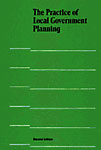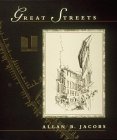The Planetizen 20 features the all-time top 20 planning titles that every planner should read. Planetizen's annual lists features the top 10 popular titles published during each preceeding year. Planetizen has partnered with Amazon.com to enable you to purchase any title by selecting the linked title of the book.
Also, be sure to check out our Store for the latest books in urban planning, design and development.
Top 20 All-Time Urban Planning Titles
Top 20 all-time urban planning books that every urban planner should read.The Death and Life of Great American Cities
by Jane Jacobs (1961)A classic since its publication in 1961, this book is the defintive statement on American cities: what makes them safe, how they function, and why all too many official attempts at saving them have failed. The New York Times writes: "Perhaps the most influential single work in the history of town planning."
The City in History: Its Origins, Its Transformations, and Its Prospectsby Lewis Mumford (1972)
A history of the forms and functions of the city throughout the ages, and a prophecy for the future of cities and urban life. The City in History was awarded the National Book Award in 1962.
The Practice of Local Government Planning (Municipal Management Series)by Charles Hoch (2000)
First published in 1916 by the National Municipal League, this reference text is now called simply "The Green Book", and has become the benchmark for planning in the United States.
Civilizing American Cities: Writings on City Landscapesby Frederick Law Olmsted (1997)
Civilizing American Cities collects Olmsted's plans for New York, San Francisco, Buffalo, Montreal, Chicago, and Boston; his suburban plans for Berkeley, California and Riverside, Illinois; and a generous helping of his writings on urban landscape in general. These selections, expertly edited and introduced, are not only enjoyable but essential reading for anyone interested in the history--and the future--of America's cities.
The Image of the Cityby Kevin Lynch (1960)
What does the city's form actually mean to the people who live there? What can the city planner do to make the city's image more vivid and memorable to the city dweller? To answer these questions, Mr. Lynch, supported by studies of Los Angeles, Boston, and Jersey City, formulates a new criterion -- imageability -- and shows its potential value as a guide for the building and rebuilding of cities.
The American City: What Works and What Doesn't
by Alexander Garvin (1995)This definitive sourcebook on urban planning points out what has and hasn't worked in the ongoing attempt to solve the continuing problems of American cities. Hundreds of examples and case studies clearly illustrate successes and failures in urban planning and regeneration, including examples of the often misunderstood and maligned "Comprehensive Plan."
Good City Form
by Kevin Lynch (1995)Lynch looks at connections between human values and the physical forms of cities, sets requirements for a normative theory of city form, reviews earlier physical images of what utopian communities might be, sees what is to be learned from hellish images, and helps us place city forms into one or another of three theoretic constructs; cosmic or ceremonial centers, the machine city, and the city as an organism.
The Next American Metropolis: Ecology, Community, and the American Dream
by Peter Calthorpe (1993)One of the strongest supporters of New Urbanism, architect and urban designer Peter Calthrope makes the case for compact, mixed-use development over the urban sprawl that has dominated much of the development in the past decades. Twenty-four regional plans are presented in the book, focusing on reducing dependance on the automobile and increasing the proximity between home, work, shopping and recreation.
Cities of Tomorrow: An Intellectual History of Urban Planning and Design in the Twentieth Century
by Peter Geoffrey Hall (1996 Updated Edition)Cities of Tomorrow is an overview of the ideas, events, and personalities that have shaped world urbanization since 1900. The book is organized into ten chapters that treat late 19th-century slums; mass-transit suburbs; the garden city movement; the genesis of regional planning; the 'city beautiful' crusade; the skyscraper city; the city of 'sweat equity'; automobile suburbs; the city of theory; and contemporary urban redevelopment.
A Pattern Language: Towns, Buildings, Construction
by Christopher Alexander, Sara Ishikawa, and Murray Silverstein (1976)"Here's how to design or redesign any space you're living or working in -- from metropolis to room. Consider what you want to happen in the space, and then page through this book. Its radically conservative observations will spark, enhance, organize your best ideas, and a wondrous home, workplace, town will result" --San Francisco Chronicle. This handbook is designed for the layperson and aims to present a language which people can use to express themselves in their own communities or homes.
The Power Broker: Robert Moses and the Fall of New York
by Robert A. Caro (1975)The tragic story of Robert Moses, whose use and abuse of power shaped the politics, the physical structure and even the problems of urban decline in New York.
Edge City: Life on the New Frontier
by Joel Garreau (1992)First there was downtown. Then there were suburbs. Then there were malls. Then Americans launched the most sweeping change in 100 years in how they live, work, and play--The Edge City.
The Geography of Nowhere: The Rise and Decline of America's Man-Made Landscape
by James Howard Kunstler (1995)The Geography of Nowhere traces America's evolution from a nation of Main Streets and coherent communities to a land where every place is like no place in particular, where the cities are dead zones and the countryside is a wasteland of cartoon architecture and parking lots.
The Urban Villagers
by Herbert J. Gans (l962, updated 1982)A report of a participant-observation study of an inner-city Boston neighborhood called the West End and, in particular, of the native-born Americans of Italian parentage who lived there with other ethnic groups.
The Essential William Whyte
by William Hollingsworth Whyte (2000)The result of William Whyte's research is an extremely human, often amusing look at what goes on in our cities' streets. The original title, City: Rediscovering the Center, is out of print. This edition is a collection of much of the original work.
Design With Nature
by Ian L. McHarg (1995)The first book to describe an ecologically sound approach to the planning and design of communities, Design with Nature has done much over the past 25 years to shape public environmental policy. This paperback edition makes this classic accessible to a wider audience than ever before. Lavishly illustrated with more than 300 color photos and line drawings.
Nature's Metropolis : Chicago and the Great West
by William Cronon (1992)In this groundbreaking work, a Yale University professor of history gives an environmental perspective on the history of 19th-century America. "No one has written about Chicago with more power, clarity, and intelligence than Cronon. Indeed, no one has ever written a better book about a city." --Boston Globe
Silent Spring
by Rachel Carson (1962)Rarely does a single book alter the course of history, but Rachel Carson's Silent Spring did exactly that. The outcry that followed its publication in 1962 forced the government to ban DDT and spurred revolutionary changes in the laws affecting our air, land, and water. Carson's book was instrumental in launching the environmental planning movement. Introduction by Al Gore, Jr.
Planning in the USA: Policies, Issues, and Processes
by Barry Cullingworth, and J. Barry Cullingworth (1997)This comprehensive introduction to the policies, theory and practice of planning outlines land use, urban planning and environmental protection policies and explains the nature of the planning process.
Great Streets
by Allan B. Jacobs (1995)Which are the world's best streets, and what are the physical, designable characteristics that make them great? To answer these questions, Allan Jacobs has surveyed street users and design professionals and has studied a wide array of street types and urban spaces around the world. With more than 200 illustrations, all prepared by the author, along with analysis and statistics, Great Streets offers a wealth of information on street dimensions, plans, sections, and patterns of use, all systematically compared.
Libros de lectura obligada para cualquier profesional del urbanismo y que deberia ser requisito ineludible para cualquier persona que pretenda ocupar un puesto en la administracion publica, en todas las areas en las que se involucren temas de Desarrollo Urbano, Vivienda, Transporte, Vialidad, Accesibilidad, Movilidad y Desarrollo Social y Economico en la ciudad.





















No hay comentarios:
Publicar un comentario